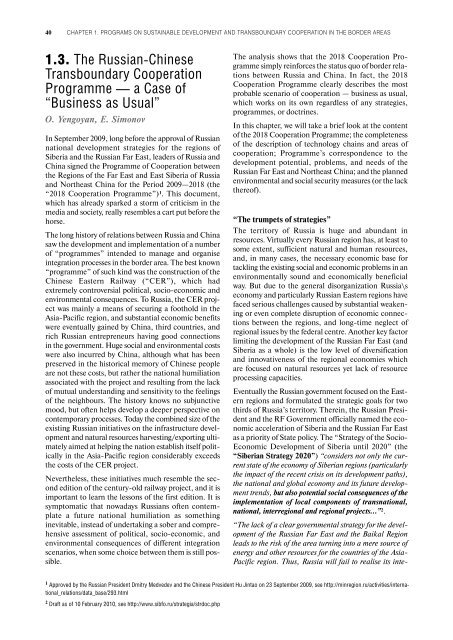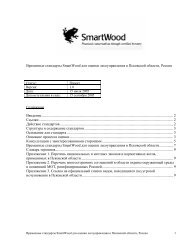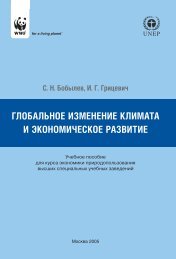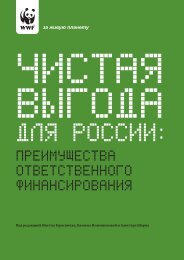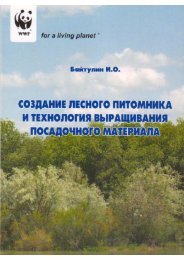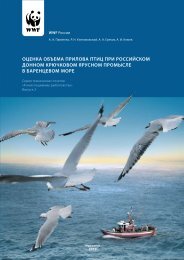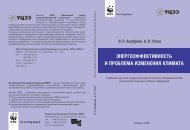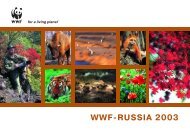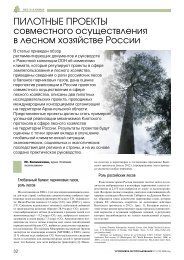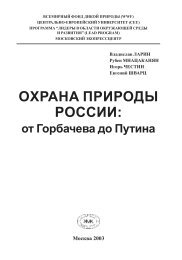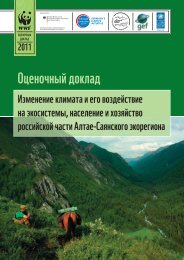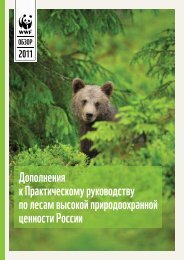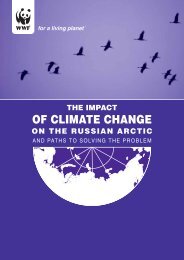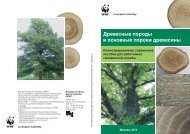to sino- russian
to sino- russian
to sino- russian
Create successful ePaper yourself
Turn your PDF publications into a flip-book with our unique Google optimized e-Paper software.
40 CHAPTER 1. PROGRAMS ON SUSTAINABLE DEVELOPMENT AND TRANSBOUNDARY COOPERATION IN THE BORDER AREAS<br />
1.3. The Russian-Chinese<br />
Transboundary Cooperation<br />
Programme — a Case of<br />
“Business as Usual”<br />
O. Yengoyan, E. Simonov<br />
In September 2009, long before the approval of Russian<br />
national development strategies for the regions of<br />
Siberia and the Russian Far East, leaders of Russia and<br />
China signed the Programme of Cooperation between<br />
the Regions of the Far East and East Siberia of Russia<br />
and Northeast China for the Period 2009—2018 (the<br />
“2018 Cooperation Programme”) 1 . This document,<br />
which has already sparked a s<strong>to</strong>rm of criticism in the<br />
media and society, really resembles a cart put before the<br />
horse.<br />
The long his<strong>to</strong>ry of relations between Russia and China<br />
saw the development and implementation of a number<br />
of “programmes” intended <strong>to</strong> manage and organise<br />
integration processes in the border area. The best known<br />
“programme” of such kind was the construction of the<br />
Chinese Eastern Railway (“CER”), which had<br />
extremely controversial political, socio-economic and<br />
environmental consequences. To Russia, the CER project<br />
was mainly a means of securing a foothold in the<br />
Asia-Pacific region, and substantial economic benefits<br />
were eventually gained by China, third countries, and<br />
rich Russian entrepreneurs having good connections<br />
in the government. Huge social and environmental costs<br />
were also incurred by China, although what has been<br />
preserved in the his<strong>to</strong>rical memory of Chinese people<br />
are not these costs, but rather the national humiliation<br />
associated with the project and resulting from the lack<br />
of mutual understanding and sensitivity <strong>to</strong> the feelings<br />
of the neighbours. The his<strong>to</strong>ry knows no subjunctive<br />
mood, but often helps develop a deeper perspective on<br />
contemporary processes. Today the combined size of the<br />
existing Russian initiatives on the infrastructure development<br />
and natural resources harvesting/exporting ultimately<br />
aimed at helping the nation establish itself politically<br />
in the Asia-Pacific region considerably exceeds<br />
the costs of the CER project.<br />
Nevertheless, these initiatives much resemble the second<br />
edition of the century-old railway project, and it is<br />
important <strong>to</strong> learn the lessons of the first edition. It is<br />
symp<strong>to</strong>matic that nowadays Russians often contemplate<br />
a future national humiliation as something<br />
inevitable, instead of undertaking a sober and comprehensive<br />
assessment of political, socio-economic, and<br />
environmental consequences of different integration<br />
scenarios, when some choice between them is still possible.<br />
The analysis shows that the 2018 Cooperation Programme<br />
simply reinforces the status quo of border relations<br />
between Russia and China. In fact, the 2018<br />
Cooperation Programme clearly describes the most<br />
probable scenario of cooperation — business as usual,<br />
which works on its own regardless of any strategies,<br />
programmes, or doctrines.<br />
In this chapter, we will take a brief look at the content<br />
of the 2018 Cooperation Programme; the completeness<br />
of the description of technology chains and areas of<br />
cooperation; Programme’s correspondence <strong>to</strong> the<br />
development potential, problems, and needs of the<br />
Russian Far East and Northeast China; and the planned<br />
environmental and social security measures (or the lack<br />
thereof).<br />
“The trumpets of strategies”<br />
The terri<strong>to</strong>ry of Russia is huge and abundant in<br />
resources. Virtually every Russian region has, at least <strong>to</strong><br />
some extent, sufficient natural and human resources,<br />
and, in many cases, the necessary economic base for<br />
tackling the existing social and economic problems in an<br />
environmentally sound and economically beneficial<br />
way. But due <strong>to</strong> the general disorganization Russia\s<br />
economy and particularly Russian Eastern regions have<br />
faced serious challenges caused by substantial weakening<br />
or even complete disruption of economic connections<br />
between the regions, and long-time neglect of<br />
regional issues by the federal centre. Another key fac<strong>to</strong>r<br />
limiting the development of the Russian Far East (and<br />
Siberia as a whole) is the low level of diversification<br />
and innovativeness of the regional economies which<br />
are focused on natural resources yet lack of resource<br />
processing capacities.<br />
Eventually the Russian government focused on the Eastern<br />
regions and formulated the strategic goals for two<br />
thirds of Russia’s terri<strong>to</strong>ry. Therein, the Russian President<br />
and the RF Government officially named the economic<br />
acceleration of Siberia and the Russian Far East<br />
as a priority of State policy. The “Strategy of the Socio-<br />
Economic Development of Siberia until 2020” (the<br />
“Siberian Strategy 2020”) “considers not only the current<br />
state of the economy of Siberian regions (particularly<br />
the impact of the recent crisis on its development paths),<br />
the national and global economy and its future development<br />
trends, but also potential social consequences of the<br />
implementation of local components of transnational,<br />
national, interregional and regional projects…” 2 .<br />
“The lack of a clear governmental strategy for the development<br />
of the Russian Far East and the Baikal Region<br />
leads <strong>to</strong> the risk of the area turning in<strong>to</strong> a mere source of<br />
energy and other resources for the countries of the Asia-<br />
Pacific region. Thus, Russia will fail <strong>to</strong> realise its inte-<br />
1 Approved by the Russian President Dmitry Medvedev and the Chinese President Hu Jintao on 23 September 2009, see http://minregion.ru/activities/international_relations/data_base/293.html<br />
2 Draft as of 10 February 2010, see http://www.sibfo.ru/strategia/strdoc.php


